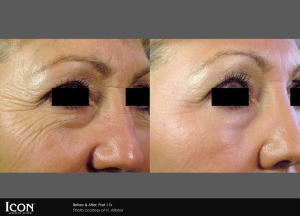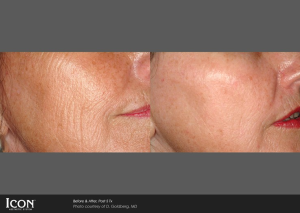Fractional lasers can tighten skin, reduce fine lines and wrinkles, fade scars, minimize the appearance of pores, and help skin look more youthful and radiant in as few as three treatments.
This laser is also the only one approved by the FDA to treat stretch marks.
Fractional laser treatment has bridged the gap between the ablative and non-ablative laser techniques used to treat sun-damaged and aging skin. While ablative laser treatments work mainly on the epidermis (surface skin cells) and non-ablative treatments work solely on dermal collagen (mid-layer of skin) only, fractional laser treatment works at both the epidermal and dermal layers of the skin.
This makes it easier than ever to improve the way your skin looks and feels, without surgery or lengthy recovery times.
Fractional, non-ablative laser skin resurfacing can quickly and easily improve a multitude of skin issues.
Laser skin resurfacing can improve the appearance of:
- Age spots
- Sun damage
- Skin tone and texture
- Wrinkles
- Surgical scars and acne scars
- Stretch marks
Before and After Photos



How does it work?
Collagen and elastin make up the support structure in our skin. As we age, that support structure weakens, forming wrinkles. The Lux1540 fractional microbeams penetrate deep into the epidermis and dermis (very deep into the skin) for effective, long term results. The fractional, non-ablative approach stimulates quick healing with no long term redness. It can be performed on most areas of the body, including the face, neck, chest, arms, abdomen, and hands. FDA approved for stretch marks. Good for all skin types.
What do I expect during the treatment?
Before the procedure begins, you will be given ample time to meet with the RN and physician to ask questions and be provided with information. You can opt to receive a topical numbing cream for the treatment area, which should be applied 30 minutes before the treatment. As the treatment begins, you will be given protective eyewear to protect you from the bright flashes of light. A cool gel is applied to the treatment area, both to lubricate the hand piece and to help cool the epidermis during the treatment. Your skin care specialist will apply brief pulses of bright light to the skin through the hand piece. The hand piece has a cooling element to it to provide additional comfort during the treatment. Depending on the size of the area being treated, the procedure may take anywhere from 15-30 minutes.
During the Laser Skin Resurfacing procedure, you will feel a warm sensation caused by the pulses of light. Some compare the sensation to a light snap from a rubber band. The number of pulses you receive will depend on the size of the area being treated, but with this treatment the pulses will need to go over the treatment area twice. Following the procedure, the laser specialist may help you in cooling down the treatment area to help soothe any discomfort from the procedure.
How long does treatment take?
Most treatments last no more than 30 minutes.
Does it hurt?
Most people feel minimal discomfort during skin revitalization. We recommend the patient coming in 30 minutes to one hour prior to apply a topical numbing agent to the treatment area. The sensation has been described by some as the light snapping of a rubber band.
How many treatments will I need?
Although you will see results after one treatment, you will see your optimal results after three treatments. Most patients are happiest after three treatments.
What are possible side effects?
Infection: Nonablative laser resurfacing can cause a flare-up of the herpes virus. Notify the office if you have a history of oral herpes prior to your treatment so that we can prophylactically prescribe medication to help mitigate any potential outbreak.
Changes in skin color. If you have darker skin, nonablative laser resurfacing can cause your skin to become temporarily darker (hyperpigmentation).
Mild swelling and redness: Swelling and redness typically last only a few hours; some patients may see mild swelling up to a few days.
Blistering and scarring. Rarely, nonablative laser resurfacing can cause blistering or scarring. Slight grid marks and dry feeling skin may be present initially, but will go away within in a week.
Surgical and Acne Scars: Visit patients.cynosure.com/treatment/surgical-and-acne-scars/ for more information and before and after photos.
Skin Revitalization: Visit patients.cynosure.com/treatment/skin-revitalization/ for more information and before and after photos.
Precautions:
- Do not go sunbathing at least 4 weeks before the IPL treatment. The lighter the skin, the more effective the treatment.
- Do not go to the sauna or swimming pool 24 hours before the treatment to avoid skin irritations caused by chlorine..
- Do not take any medications which make the skin photosensitive.
- Do without creams prior to treatment.

